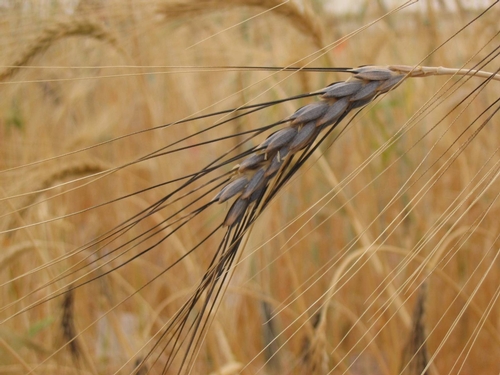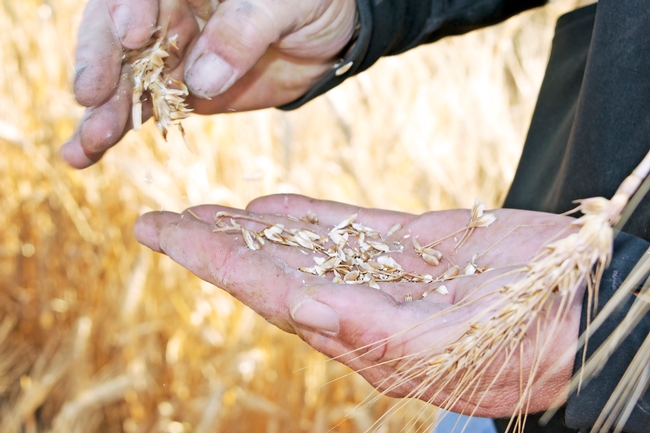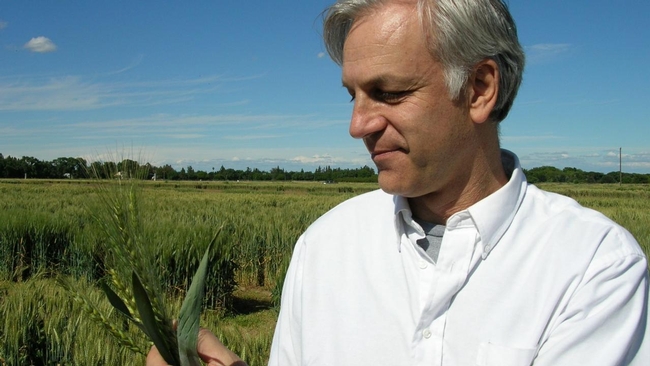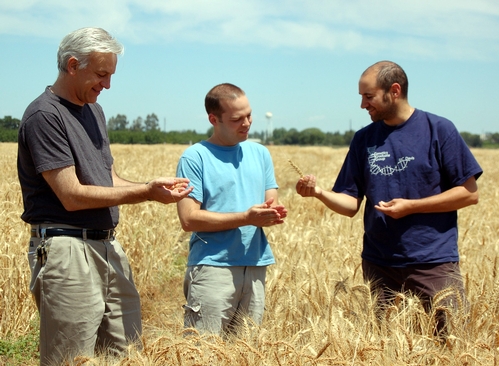Posts Tagged: Jorge Dubcovsky
UC Davis team identifies wheat gene that increases yield
The findings could help growers produce more wheat without expanding operation
A team of scientists from University of California, Davis, have identified a new gene variant in wheat that can increase the amount of the grain produced, new research published in the journal PLOS Genetics finds.
Wheat is a staple of food diets worldwide and the gene discovery could allow farmers to grow more food without increasing land use. Increased yield could also lower consumer prices, making the crop more accessible.
“We have a growing human population that likes to eat every day,” said Jorge Dubcovsky, a plant sciences distinguished professor who led the research. “We need to produce more wheat in the same space so we need plants that are more productive.”
The researchers found a gene – WAPO1 – that controls the maximum number of grains in a wheat spike. Breeding the beneficial gene variant into the plants could delay the formation of the terminal spikelet, providing room for more grains to grow in each spike rather than ending production of grain.
WAPO1 is one of the first genes discovered that can affect wheat yield. “We are trying to make more productive wheat varieties and we are starting to understand how that trait is controlled,” Dubcovsky said.
Pasta wheat lacking the gene
The gene variant for high grain number is found frequently in bread wheats but not in pasta wheats. By breeding the beneficial gene variant into those pasta wheat varieties, growers could increase yield by 4% to 5% in cultivars that have the biomass capacity to fill the extra grains.
“We developed molecular markers to select for the form of that gene to produce increased yield,” Dubcovsky said. “It's a significant step forward.”
Previous research by the team mapped the gene and identified others that could affect yield. This research confirmed those findings for WAPO1.
Discovery on path to future yield increases
The WAPO1 gene is part of a network of genes that work together to control yield, and researchers need to identify the best variant combinations to maximize yield. Solving this puzzle can lead to better production rates.
“We will continue to try to understand the network of genes that control the yield of wheat,” he said.
Saarah Kuzay, Huiqiong Lin, Chengxia Li, Shisheng Chen, Daniel P. Woods and Junli Zhang from UC Davis also contributed to the research, as did scientists from Howard Hughes Medical Institute, Heinrich Heine University and Peking University Institute of Advanced Agricultural Sciences.
Funding was provided by USDAs National Institute of Food and Agriculture's Food Research Initiative, the International Wheat Yield Partnership and Howard Hughes Medical Institute.
Pasta salad - more nutritious than ever
The ever popular pasta salad is sturdy and economical, but is it nutritious?
It sure can be, and research from UC Davis Department of Plant Sciences professor Jorge Dubcovsky is helping to make that so. Dubcovsky’s team discovered a gene in domesticated wheat that had been damaged, a gene that controls the distribution of nutrients to the grains in healthy grain plants. What’s more, they discovered a copy of that damaged gene in wild wheat, enabling them (and others) to breed new varieties with substantially increased levels of protein, iron and zinc.
Wheat provides about 20 percent of all the calories people consume worldwide. In other words, we eat a lot of it – it’s second only to rice as a human source of calories. Sometime during its domestication (some 10,000 years ago) wheat underwent a change that lowered the protein, zinc and iron content in its grain.
In 2006, after years of mapping, Dubcovsky and his team discovered the culprit - a mutation in a gene called NAM-B1. In healthy grain plants, NAM-B1 controls the remobilizing and distribution of nutrients to the grains when the leaves die off. Without a working copy of the gene, cultivated wheat is not a good processor of its nutrients, so large amounts of protein, iron and zinc are left in its straw.
Dubcovsky’s team then examined the ancestors of commercial wheat and found, amazingly enough, a fully functional NAM-B1 gene within the genome of wild emmer wheat. Emmer wheat can be freely crossed with domestic wheat using conventional means, so no controversial genetic engineering methods were needed to restore the lost gene.
The University of California has already released one variety – Lassik - with the increased nutritional punch. Lassik also is genetically improved for stronger gluten and resistance to both stripe-rust and leaf-rust disease. And because the new strains were bred from widely used commercial varieties, the new variety retains its farmer-friendly characteristics such as high yield and consumer-friendly trait like excellent taste.
The new plants are in the public domain, distributed to breeders across the globe. Some 2 billion people around the world lack adequate micronutrients, so more nutritious wheat could make a big difference in fighting world hunger.
So when friends ask, “What’s the secret to your fantastic pasta salad?” you know what to say:
“Protein, iron and zinc.”
For more on what the UC Davis Department of Plant Sciences is doing to make our salads more tasty, nutritious, safe and affordable, see The Spring 2010 Leaflet

Wild wheat, Triticum turgidum ssp. dicoccoides




